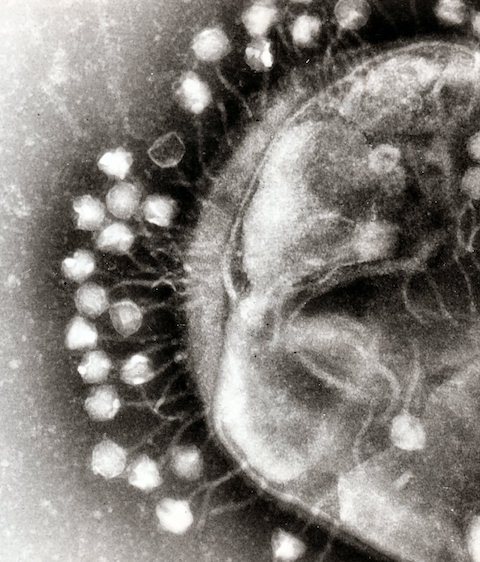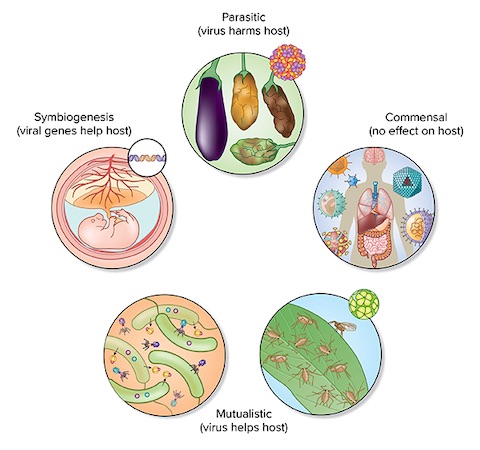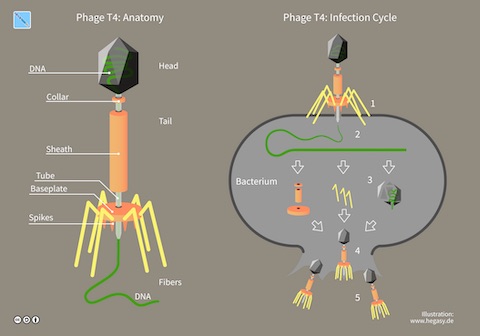
You might have heard of your microbiome, but did you know you also have a virome? That’s right, there are more than a trillion active viruses within you right now.
Viruses exist in every organism, in every environment. There are at least ten times more viruses on Earth than all other biological entities combined.
A virus is a tiny packet of RNA or DNA, about 1500 times smaller than a grain of salt.
They lack the ability to reproduce or the ribosomes to make energy. Many scientists don’t even consider them to be alive. They can only flourish within the cells of their hosts.
When a virus enters a cell, its genetic code instructs the cell to replicate it. Not really reproduction, but duplication.
When the cell is spent, it releases these newly created viruses to repeat the process.
Most viruses are symbiotic and beneficial to the host.
Some attack bacteria, as in our gut. Some provide genes the host can use, like those that protect plants from drought or cold. Others leave behind bits of genetic code that have helped hosts evolve, something we talk about on other episodes.
Pathogenic viruses harm or kill the host, but there are only about 200 that infect humans, like the coronaviruses that cause the common cold and COVID-19.
Though these rogue actors have given viruses a bad name, the truth is, we couldn’t live without our friendly virome.
Background
Synopsis: You may have heard of your microbiome, but did you know you also have your very own virome? There are trillions of viruses in the human body. They live in us, but they aren’t actually “alive.” A tiny fraction are harmful parasites, while the rest are benign symbionts: some are helpful protectors while others are just hitchhiking. How do viruses work, anyway?
- There are at least 10 times more viruses on Earth than the sum of all other biological entities. They are everywhere, in every Earth ecosystem. They may even be in space.
- In addition to its microbiome, every human body has its own virome with hundreds of trillions of viruses—10 times as many as there are bacteria in the microbiome.
- There are at least 200 different kinds of viruses in the human body at any time.
- Other mammals add a few hundred thousand more types of virus to the count.
- Other animals, plants, and even fungi have their own viromes too.
- Adding it all up gives us a very big number—at least 10 nonillion (1031) individual viruses are estimated to exist on Earth.
- Viruses live in us. But based on the current definition, they aren’t actually “alive.” They are missing some of the key characteristics we expect in living cells.
- We define living organisms (animals, plants, fungus, bacteria, and archaea) based on their ability to grow, reproduce, respond to stimuli, maintain internal equilibrium, and carry out metabolic processes.
- Viruses lack ribosomes and are unable to form proteins or generate energy producing adenosine triphosphate (ATP).
- Lacking metabolic capabilities, they can only replicate within a living host cell.
- Though they don’t fit our strict definition of life, some researchers think they might simply be a different type of life than we have previously recognized.
- Note: Researchers sometimes refer virus vaccines like those for polio, whooping cough, or rabies as “dead” or “killed.” They are referring to the use of inactivated pieces of these viruses. “Live” virus vaccines, like those for measles, mumps, rubella, and chickenpox, are made with weakened or attenuated forms of the viruses.
- There are many different families of viruses, and most are friendly.
- Friendly viruses are known as “obligate intracellular symbionts.” They are obliged to replicate symbiotically inside of a living cell.
- Both the host and the virus benefit from symbiotic relationships.
- Some viruses, like bacteriophages, help the host immediately by stalking and killing harmful bacteria, such as those that might be found in the human gut.
- Others help their host over the course of generations by providing helpful genes, such as those that protect plants from drought or cold.
- Some viruses leave behind bits of their genetic code that enable critical evolutionary steps.
- Still others just ride along with no known effect on their host.
- Of all known viruses, researchers estimate that fewer than 1% are pathogenic.
- Harmful viruses are referred to as “obligate intracellular parasites.”
- Only about 200 viruses are known to be harmful to humans.
- Some of the human diseases caused by viral pathogens include influenza, Ebola, HIV/AIDS, polio, smallpox, rabies, measles, and coronaviruses like the common cold and COVID-19.

- Viruses are basically tiny packets consisting of either RNA (like the polio virus) or DNA (like the herpes virus) wrapped up in a protein jacket.
- Most viruses are very tiny, averaging about 200 nanometers—that's 1500 times smaller than a grain of salt. The largest mimivirus is 750 nm, whereas poliovirus is only 30 nm.
- Once viruses unlock and enter a cell, they hijack its cellular machinery with a simple goal: make more viruses.
- The genetic material in the virus basically provides the host cell with instructions directing precisely what to make and a schedule of precisely when to make it.
- Mistakes in the replication process can cause virus mutations, and some viruses are able to quality control their replication.
- When the host cell is spent, it spews newly created viruses into the organism to take over more cells, repeating the replication process.

- For pathogens, this process ultimately weakens the organism, sometimes killing it.
- Antibiotics kill off foreign bacterial cells, but they don’t have any effect on viral pathogens.
- Viruses occupy the host organism’s own cells, so they are harder to eliminate.
- Antiviral medications can only work by blocking the way a virus enters cells or by blocking the way a virus replicates within a cell.

